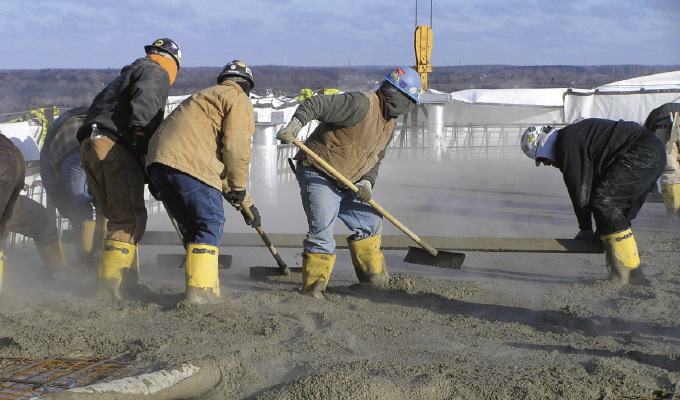As temperatures drop, concrete contractors face a familiar dilemma: press on through winter or pause production until spring. Cold weather has long carried a stigma of risk, from delayed set times and weak early strength to increased cracking and scaling. Yet with the right preparation and technical approach, winter concreting can be not only feasible but successful. The real challenge isn’t the weather itself—it’s the persistence of outdated myths that lead to costly mistakes.
MYTH 1: “JUST ADD MORE CEMENT”
Perhaps the most enduring cold-weather myth is the belief that adding more cement will offset low temperatures. While cement hydration does produce heat, simply increasing cement content is rarely the right solution. Without adjusting water content, admixtures, or aggregate temperature, this shortcut upsets the mix balance and can cause shrinkage, cracking, and long-term durability loss.
The truth is that the additional heat from extra cement is short-lived and often insufficient to prevent freezing in the critical early hours after placement. Moreover, the resulting higher paste volume increases drying shrinkage potential and permeability, both of which can shorten service life.
The better strategy is to work with your ready-mix supplier to maintain the designed water-to-cementitious ratio—typically between 0.40 and 0.50—and then incorporate accelerating admixtures that enhance early hydration without compromising concrete’s long-term strength.
MYTH 2: “CONCRETE ONLY FREEZES BELOW 32°F”
Freezing damage begins well before the thermometer hits 32°F. As temperatures dip into the 40s, the hydration process slows dramatically. The chemical reaction between tricalcium silicate (C₃S) and water, which drives early strength gain, becomes sluggish—which doubles or even triples set times. If the mix drops below freezing before reaching roughly 500 psi (3.4 MPa), the pore water inside can freeze, expand and create microcracks that permanently weaken the structure.
This early-stage damage is often invisible until weeks later, when surface scaling or delamination appears under traffic or deicing salts. Even after finishing, protection remains crucial. Concrete continues curing for days, and exposure to freeze-thaw cycles or rapid temperature swings can interrupt the formation of calcium-silicate-hydrate (C-S-H) gel—the backbone of concrete’s strength and durability. Cold-weather concreting isn’t about one critical temperature threshold. It’s about maintaining consistent curing conditions from placement through early strength development.
MYTH 3: “CALCIUM CHLORIDE IS THE BEST ACCELERATOR”
Calcium chloride remains one of the most efficient accelerators available, but its drawbacks can outweigh the benefits. This is because its chloride ions can actually corrode embedded steel reinforcement and discolor decorative or exposed surfaces. When finishing high-visibility slabs, post-tensioned members, or structures with rebar, calcium chloride should be avoided.
Modern non-chloride accelerators, which are based on calcium nitrate, calcium formate or triethanolamine chemistry, offer similar performance without the corrosion risk. They promote early hydration of C₃S and C₂S phases and are compatible with most air-entraining and water-reducing admixtures. In fact, these formulations are particularly effective when paired with mix adjustments such as lower supplementary cementitious material (SCM) percentages and optimized aggregate gradation to maintain workability in colder conditions.
MYTH 4: “YOU CAN SKIP HEATING IF YOU POUR DURING THE DAY”
Sunlight offers little protection for concrete once ambient temperatures begin to drop. In fact, concrete’s internal heat will dissipate quickly if placed on a frozen subgrade or exposed to cold air. When the base temperature is below 32°F, the concrete mix can lose heat faster than it generates it—leading to delayed strength gain, curling, or cracking as the slab thaws unevenly.
Proper temperature control starts with preheating water (140°F or less) and aggregates (roughly 100°F) so that mixed concrete is delivered between 55°F and 65°F. Subgrades must be thawed and moisture-free to prevent flash freezing. Once placed, concrete should be protected immediately with insulated curing blankets or heated enclosures to retain internal heat until the mix achieves 500 psi.
A good rule of thumb is to maintain the concrete’s surface temperature above 50°F for the first 48 hours and above 40°F for the next several days. Thermocouples or maturity sensors embedded in the slab can verify when adequate strength has been reached before removing protection. For large placements, hydronic heating hoses or heated formwork can provide uniform curing conditions.
MYTH 5: “COLD-WEATHER MEASURES ARE TOO COSTLY”
While winter concreting requires additional effort such as heating, insulation, and longer cure times, the return on investment is significant. The cost of blankets and fuel is minor compared to the price of rework, surface scaling, or structural repair caused by early freezing. To add to this, protecting concrete during the first 72 hours can increase final compressive strength by 20–30 percent, according to ACI 306R.
By integrating temperature management, mix optimization, and disciplined curing, concrete contractors can extend their working season and maintain productivity. Fewer shutdowns mean steadier cash flow and a stronger reputation for reliability. Winter work done right demonstrates technical proficiency and builds trust with owners who expect performance regardless of season.
RETHINKING WINTER WORK
In a nutshell, here’s the underlying truth: concrete responds to chemistry, not climate. Cold weather really just changes how concrete needs to be managed. Hydration slows in cold conditions but never actually stops—and when properly managed, it produces denser, more durable concrete.
To add to this, mix designs can be optimized for temperature control and predictable performance. Non-chloride accelerators help maintain schedules, shrinkage-reducing admixtures minimize thermal stress, and adjusted SCM contents preserve early strength while maintaining long-term durability.
Contractors who understand this can transform winter work into a competitive edge by applying science with discipline—ultimately extending their season while delivering consistent quality.

about the author
Jennifer Mizer is the director of marketing services at Euclid Chemical, a leading manufacturer of specialty concrete and masonry construction solutions. A 20-plus-year industry veteran, Mizer manages the marketing communications activities for Euclid’s expansive line of admixtures, fiber reinforcement, concrete repair products, flooring materials and decorative concrete systems. For more, visit www.euclidchemical.com.


